|
|
|||||
|
|
|||||
|
Counter added Sunday, March 25, 2007 -11:00 am Pacific Time
|
|||||
|
|
|
Saturday, August 18, 2007 – Pretty Poison It was that trip to the south of France in late June seven years ago – the ride on the screamingly fast TGV from Paris to Avignon then picking up the rental car at the train station, then finding the Bed and Breakfast place on an island in the Rhone a mile or two north of the old walled city and that famous bridge that's still there. Yeah, you know that song. The place was fine, an old estate from the sixteenth century (it's way cool), but there was this touch of Los Angeles about it – the pink and white oleander (Nerium oleander) everywhere. Oleander is pretty enough, and the blooms smell quite nice, but we have it all over here – planted along the streets, in the hills, around public buildings. It screams Southern California. Of course one would expect oleander from Aix to Arles and up to Avignon. The climate is the same, and the geology and soil. Ah well, it was a touch of home. You should also know it's quite poisonous – see the text that follows these photographs. These blooms are on Curson, in the four block stretch between Sunset Boulevard to the south and Hollywood Boulevard to the north, a quiet neighborhood of craftsman cottages and shade. |
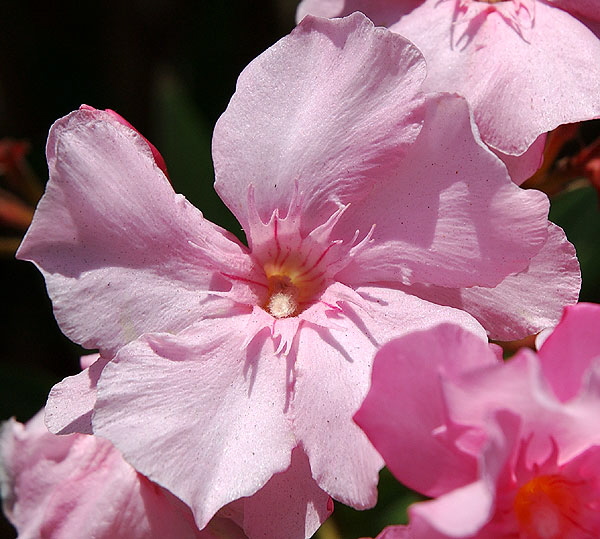 |
||||
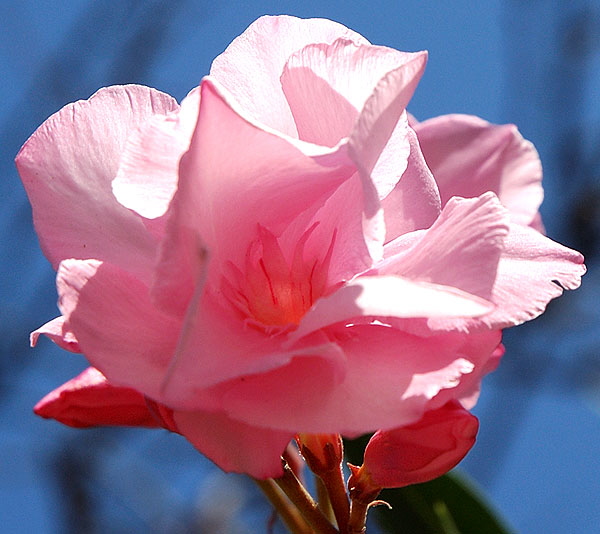 |
||||
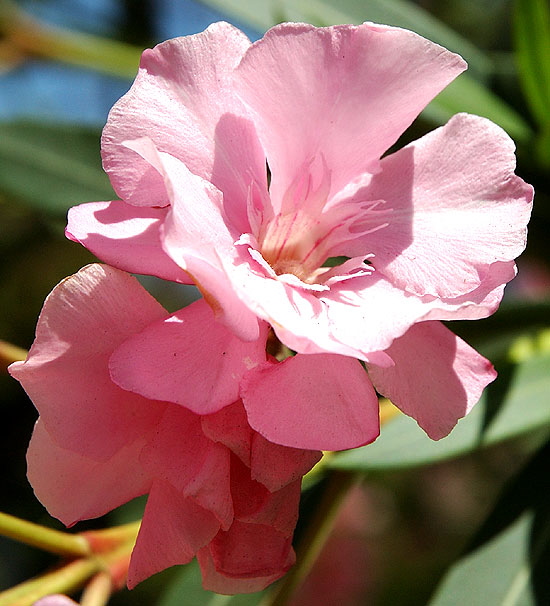 |
||||
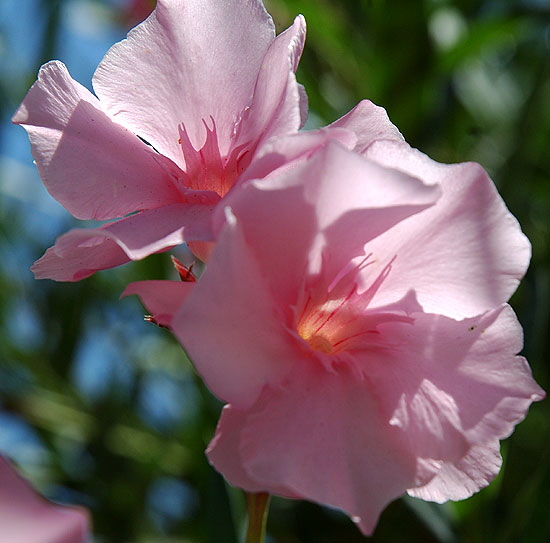 |
||||
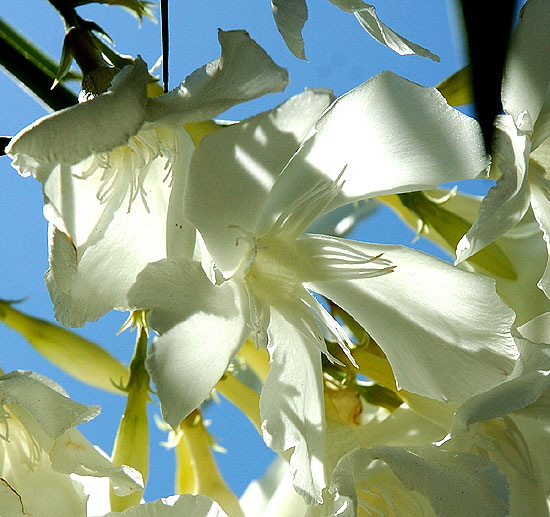 |
||||
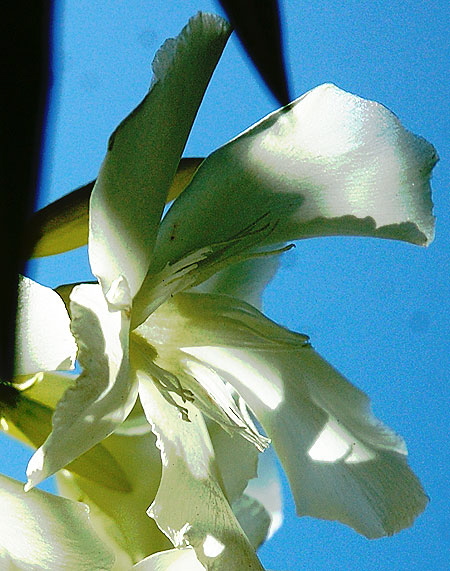 |
||||
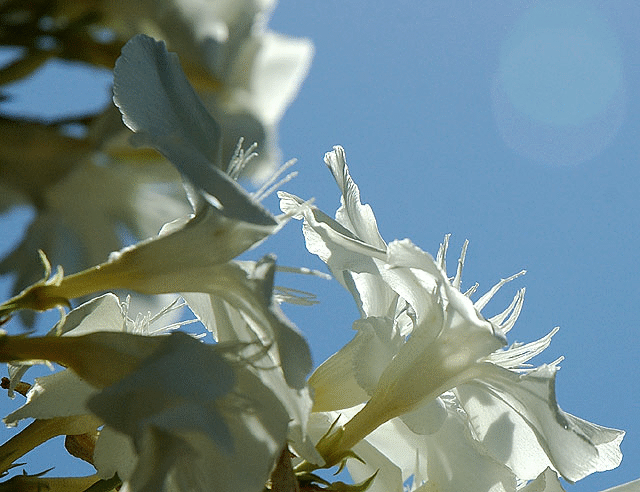 |
|
Notes:
Oleander (Nerium oleander), is an evergreen shrub or small tree in the dogbane family Apocynaceae. It is the only species currently classified in the genus Nerium. Other names include Adelfa, Alheli Extranjero, Baladre, Espirradeira, Flor de São Jose, Laurel de jardín, Laurel rosa, Laurier rose, Flourier rose, Olean, Aiwa, Rosa Francesca, Rosa Laurel, and Rose-bay. It is native to a broad area from Morocco and Portugal eastward through the Mediterranean region and southern Asia to Yunnan in southern China. Over 400 cultivars have been named, with several additional flower colours not found in wild plants having been selected, including red, purple and orange; white and a variety of pinks are the most common. Many cultivars also have double flowers. Kingdom: Plantae Division: Magnoliophyta Class: Magnoliopsida Order: Gentianales Family: Apocynaceae Genus: Nerium L. Species: N. oleander Oleander is one of the most poisonous plants and contains numerous toxic compounds, many of which can be deadly to people, especially young children. The toxicity of Oleander is considered extremely high and it has been reported that in some cases only a small amount had lethal or near lethal effects. According to the Toxic Exposure Surveillance System (TESS) in 2002 there were 847 known human poisonings in the United States related to Oleander. Ingestion can cause both gastrointestinal and cardiac effects. The gastrointestinal effects can consist of nausea and vomiting, excess salivation, abdominal pain, diarrhea that may or may not contain blood, and especially in horses, colic. Cardiac reactions consist of irregular heart rate, sometimes characterized by a racing heart at first that then slows to below normal further along in the reaction. The heart may also beat erratically with no sign of a specific rhythm. Extremities may become pale and cold due to poor or irregular circulation. Reactions to poisonings from this plant can also affect the central nervous system. These symptoms can include drowsiness, tremors or shaking of the muscles, seizures, collapse, and even coma that can lead to death. Oleander sap can cause skin irritations, severe eye inflammation and irritation, and allergy reactions characterized by dermatitis. Drying of plant materials does not eliminate the toxins. It is also hazardous for animals such as sheep, horses, cattle, and other grazing animals, with as little as 100 g being enough to kill an adult horse. |
|
If you wish to use any of these photos for commercial purposes I assume you'll discuss that with me. And should you choose to download any of these images and use them invoking the "fair use" provisions of the Copyright Act of 1976, please provide credit, and, on the web, a link back this site. Technical Note: Most of these photographs were shot with a Nikon D70 - using lens (1) AF-S Nikkor 18-70 mm 1:35-4.5G ED, or (2) AF Nikkor 70-300mm telephoto, or after 5 June 2006, (3) AF-S DX Zoom-Nikkor, 55-200 mm f/4-5.6G ED. They were modified for web posting using Adobe Photoshop 7.0. Earlier photography was done with a Sony Mavica digital still camera (MVC-FD-88) with built-in digital zoom. |
| [Pretty Poison] |
|
All text and photos, unless otherwise noted, Copyright © 2003, 2004, 2005, 2006, 2007, 2008, 2009, 2010 - Alan M. Pavlik |
